Featured This Month
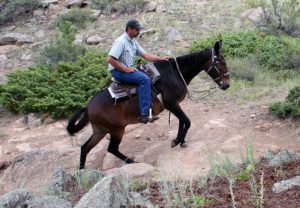
MULE CROSSING: On the Trail with Mules
By Meredith Hodges With the hectic schedule of spring and summer slowly tapering into fall, thoughts of cool, refreshing mountain streams, the sight of a massive bull elk, or the quiet majesty of the rugged mountain peaks on a relaxing trail ride, mountain hunt or pack trip begin to ease their way into our minds. What better time to share with your mule or donkey? What better place for him to show you what he was born to do? A mountain trail ride or pack trip are both perfect ways for you to get to really know your Longears and strengthen the bond between you. Mules are remarkably strong and durable animals, making them excellent mountain partners. The cupped shape of their hooves allows them to track the rough mountain terrain with much more surefootedness than their counterpart, the horse. A mule’s superior intelligence and strong sense of survival help him to carefully negotiate the placement of his feet, insuring the safest ride possible. This is both important and comforting to know when heading for the mountains. The mule’s strength and endurance are sometimes unbelievable, but always dependable. On a hunting trip, he will take you through rough mountain terrain ...
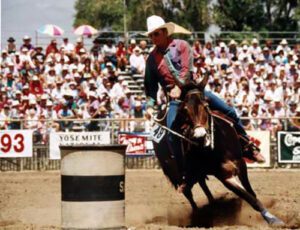
MULE CROSSING: Surge of Mule Shows
By Meredith Hodges I remember back in 1982 when summer came and we had to search high and low for shows in which we could compete with our mules! As they say, "You've come a long way, baby!" Mule shows are now so numerous that it is becoming very difficult to decide which ones to attend. Years ago, our mules were not necessarily welcome at horse competitions, and today that has changed as well – making our decisions about where to compete is even more complicated. It is truly amazing to see the tremendous growth in popularity of the mule over the past 30 to 40 years, but then I guess it was inevitable given all their redeeming qualities! It really isn't that unusual that people would begin to prefer mules once they received accurate and truthful information about them. Granted, you have to be smarter than the mule in order to train one, but once you train one properly, you have a wonderful companion and a top competitor in the equine world. More and more, the criticism of mules has changed to general curiosity and a willingness to learn more about these unique animals. Many people have taken a ...
All Articles
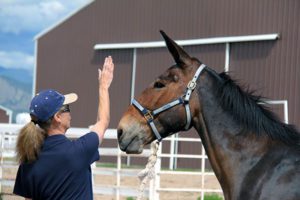
MULE CROSSING: Understanding Behavior Modification
By Meredith Hodges When people think of Behavior Modification, most people think of the most basic idea of rewarding good behaviors with treats, which is called positive reinforcement. A common misconception is that if the positive behaviors are rewarded, then negative behaviors should not occur, but in reality, they do. Negative behaviors need to be negatively reinforced, but negative reinforcement should not be abusive. Learning how to employ Behavior Modification can be easy and fun. Scientifically speaking, Behavior Modification is a direct and literal translation of stimulus and response. Given a certain stimulus, a living being will respond in a predictable manner. This is the essence of communication. Communication is comprised of a lot of elements that all play an important part in the receiver’s ability to understand. When trying to communicate, one needs to realize the many different perceptions that can arise from the receiver’s ability to comprehend. They may perceive from a purely technical level, a scientific level, an emotional level, a physical level, or any combination of a multitude of perceptions depending on their life experience. It is the same for all living creatures. Finding the right stimulus for each individual and implementing it properly is the key to good communication and a satisfying response. When using Behavior Modification, one needs to take into account all the things that can make that individual a comfortable and happy individual. In the case of equines, we need to take into account the feeding and nutritional programs we use. Certain feeds can actually cause problems like nervousness, anxiety and hypertension that result in an inability to be calm and receptive to incoming information. From this evolves negative behaviors that further block the learning process. In addition to feeds and nutrition, we need to take into account the anatomical ramifications ...
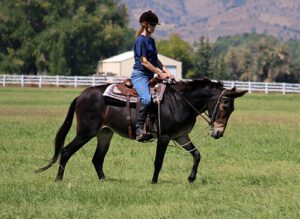
MULE CROSSING: Understanding the Use of Cruppers and Breeching
By Meredith Hodges
- The purpose of tack and equipment has always been to give man comfort and leverage against the equine’s resistance during training, but I believe that the equine is “talking” with his resistance, and this is a cue to find another alternative to achieve harmony when something isn’t working.
- Trail Riding and Jumping are two activities where it is positively essential to do core postural training with your equine to solidify his symmetrical balance when in motion, or even standing still.
- The animal with deliberate foot placement and a solid balance is a much safer smoother riding animal.
- There is an ongoing discussion about the use of cruppers and breeching when riding mules and donkeys, and even some horses. The purpose of both is to keep the saddle from sliding forward when the equine is in motion, whether he is tracking on flat ground or going up and down hills. Inappropriate use of both devices could give the equine problems.
- Whether or not to use a crupper or breeching is not an either/or decision. My equines taught me that in order to make an educated decision about which to use, one needs to take into account the anatomy of the equine and the effect of a lot of moving parts have on his body in motion during different activities.
- Good conformation is important in allowing the equine to perform to the best of his ability, but so is developing core strength elements such that the skeleton is ideally being supported symmetrically so the equine’s body can move properly and in good equine posture.
- FEEDING: When developing the equine’s body, it is important to know what feeds are the healthiest for him. There are lots of different ways to feed your equines today, but I have found a ...

MULE CROSSING: Understanding the Use of Cruppers and Breeching (DO NOT USE)
By Meredith Hodges The purpose of tack and equipment has always been to give man leverage against the equine’s resistance during training, but I believe that the equine is “talking” with his resistance and this is a cue to find another alternative to achieve harmony when something isn’t working. There is an ongoing discussion about the use of cruppers and breeching when riding mules and donkeys, and even some horses. The purpose of both is to keep the saddle from sliding forward when the equine is in motion, whether he is tracking on flat ground or going up and down hills. Inappropriate use of both devices could give the equine problems. Whether or not to use a crupper or breeching is not an either/or decision. My equines taught me that in order to make an educated decision about which to use, one needs to take into account the anatomy of the equine and the effect that each has on his body in motion during different activities. Good conformation is important in allowing the equine to perform to the best of his ability, but the tack we use has an effect on the equine’s movement in spite of his shape. In order to obtain freedom of movement, the elements of the equine’s anatomy must be allowed to move freely through every joint of his body. Energy and blood circulation finds open tracks throughout the body and when unobstructed, will run freely from the core of the body to the extremities in a healthy equine. Core and bulk muscles that are developed symmetrically support the skeletal frame, the cartilage and ligaments that surround the joints, and the tendons that tie the skeletal frame together. All work to support the proper internal organ functions and when the equine in good posture with symmetrical ...
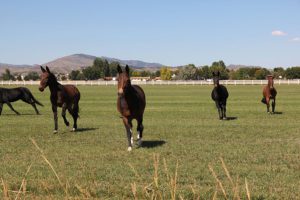
MULE CROSSING: Why Mules Are Exceptional
By Meredith Hodges Across the United States and around the world, as mules are given more and more opportunities to perform in many diverse situations, they are exhibiting their exceptional beauty, athletic ability, endurance and intelligence. There are definite physical and psychological reasons for these outstanding abilities. It has been proven that the mule not only inherits the mare’s beauty, but is also more athletic than the mare out of which he came. The mule is an exceptional hybrid not only because he inherits these qualities from his dam, the mare, but he also inherits the best qualities from his sire, the jack who is responsible for his muscle structure, thickness of bone, strength and intelligence. The muscle structure of a mule is noticeably different than that of a horse. His body is covered with masses of long, smooth muscle whereas the horse has more differentiated bulk muscle masses. The most apparent example of this difference is seen in the chest of the mule. The horse’s chest has two distinct muscle groups, which creates a very distinctive line of separation in the middle of his chest. However, the mule’s chest is composed of one wide muscle mass that resembles a turkey’s breast, which greatly enhances the mobility of the front quarters. Another example is found in the mule’s hindquarters, where the long, wide and smooth muscles enable the mule to kick forward, backwards and sideways—he can even scratch the top of his head with a hind foot if he wants to! Mules are also quite capable of climbing under, over and through most kinds of fencing. Restraints that are used with horses often do not work with mules because of their astounding ability to free themselves from annoying circumstances with their strong, quick and agile movements. Because the hindquarters ...
